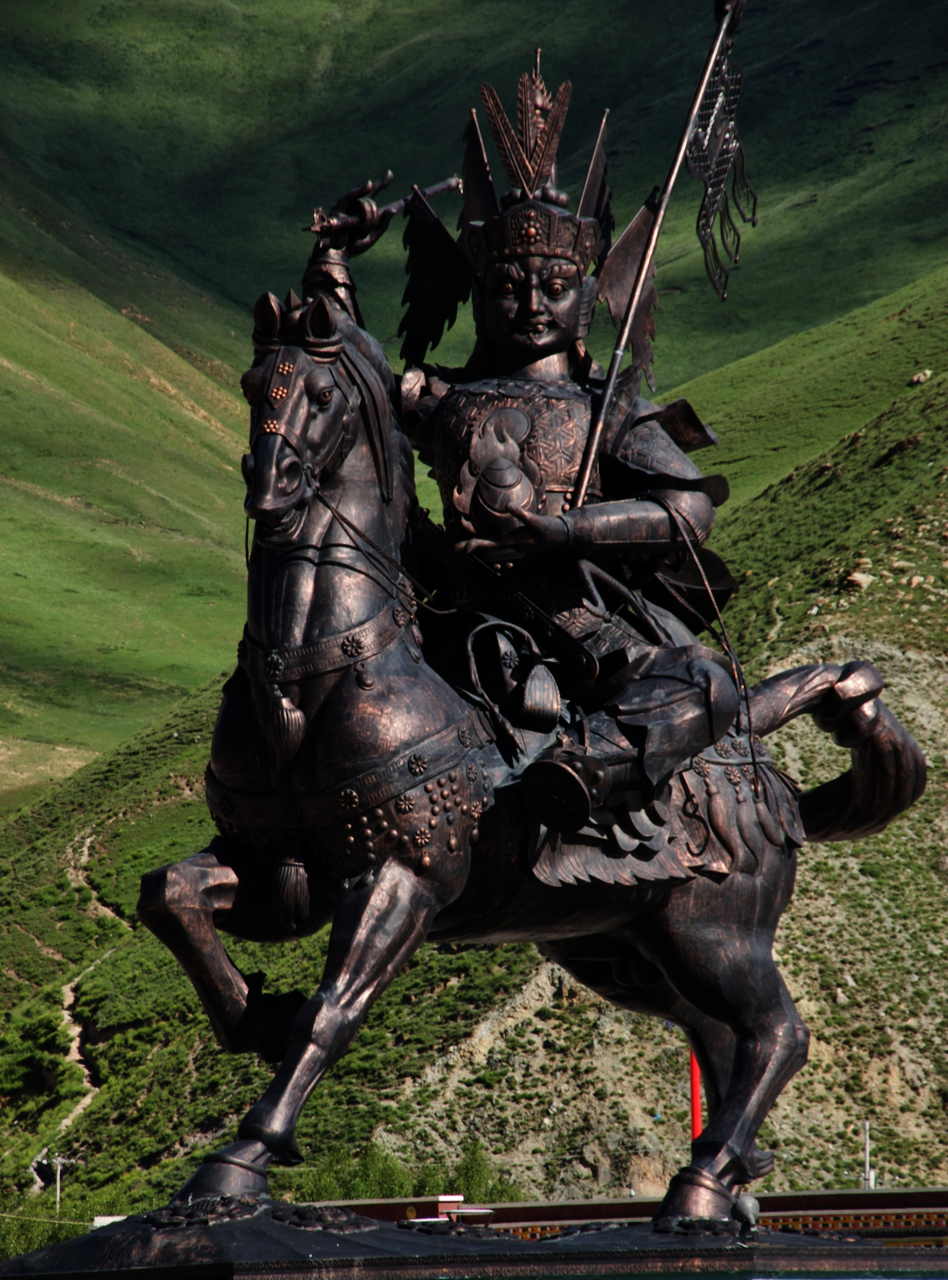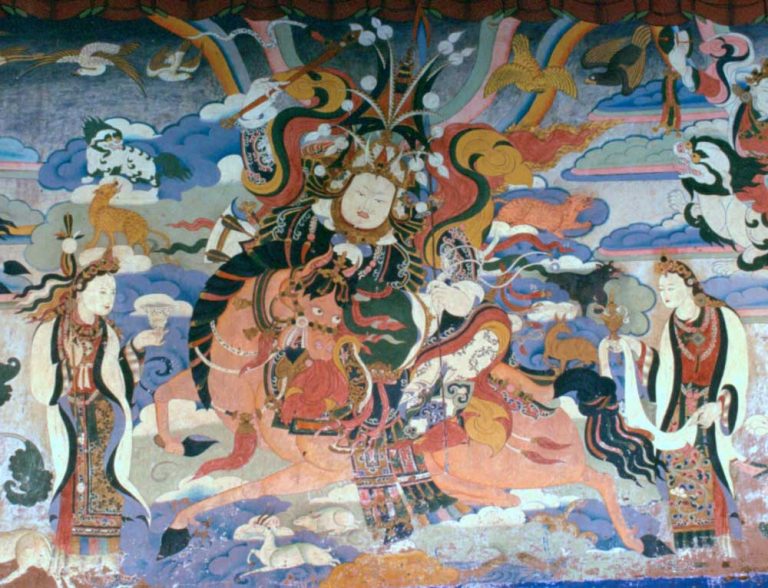The Chinese occupation of Tibet starting in 1951, and the CCP’s deliberate attempt to destroy traditional culture and values, led to the tragic loss of many cultural relics and traditional practices. The ancient art of storytelling survives, however, in the ongoing recitation of the Epic of King Gesar of Ling. This Tibetan classic is a thousand-year-old heroic ballad written during the 11th Century from a collection of legends, myths, proverbs and verses. It Is regarded as the apex of Tibetan literature.
Oral traditions entrust the memory and transmission of a narrative to a single person. One would need to be able to sing and recall a song 25 times as long as the Greek Iliad to perform this Tibetan epic. Much like the Homeric epics, it was transmitted orally for centuries. The hundreds of myths, folktales, ballads, and proverbs passed down through oral tradition educate listeners in history, religion, custom, morality, and science.
Gesar is regarded as the longest epic ever written. Reciting all the episodes takes around three months to finish. They comprise more than one million verses, and 20 million words. The subject of this magnificent ballad is the legendary King Gesar.
Bardic dreamers and Tibetan dancers
Several of Dzogchen’s branch monasteries still perform the world-famous King Gesar dance in Tibet, an annual event that takes place during the Tibetan New Year. The episodes are performed through the winter, exclusively at night. They follow a set schedule and each one takes many nights to complete. The recitation is done by male ‘drungpas’ or female ‘drungmas,’ attendants trained in Kagyu tradition.
Merging the stories of Ling with sacred dances of the vajra deities, the dance is a beautiful performance that is considered a great blessing to watch. Gaser’s horse’s hoof prints are supposed to have appeared in a cleared circle around which the crowd sat one night.
Success
You are now signed up for our newsletter
Success
Check your email to complete sign up
Storytellers and singers are keeping regional variations of the legacy of King Gesar alive by performing alternating prose and verse passages of the episodes, or ‘beads on a string.’ Tibetan bards employ bronze mirrors, facial emotions, sound effects, and gesticulations to enhance their artistic performance.
Gesar is often depicted in early Tibetan religious artwork as a hybrid between a deity, a dragon, and a ferocious spirit. He was believed to have been invincible because he was sheltered from attack by the God of Heaven. All the characters in the epic are portrayed vividly and realistically.
A short biography of King Gesar can be viewed in the video below:
Tibetan belief
In one episode The Song of King Gesar begins in the luscious grasslands of the kingdom of Ling, which resembles a massive drum, rising slightly in the center. Snow-capped mountains surround the meadows. Back then, Ling was known as Gling. It was a tiny realm with a clan structure. The people of Gling grew hemp and silk, planted seeds, built statues, and became cultured.
They thought they had destroyed all devils; but humans, deities, and demons were fated to clash. The inhabitants of Ling were led astray by the demons of desire, greed and lust. The kingdom of Ling became a battlefield, with everyone struggling against one another; and the people suffered pestilence, conflict and unrest.
The Goddess of mercy and compassion, Avalokitesvara, felt sorry for the people and begged the peaceful deity, Amitabha Buddha, to send the son of the God of Heaven to defeat the evil. The divine beings agreed, “We should do something to stop this.” They sent Gesar, the god’s bravest child, to the human realm to combat the demons that plagued ordinary people.
Tibetan belief regards Gesar as the reincarnation of Guru Padmasambhava, or “Lotus Essence,” who disseminated Buddhism across Tibet. The righteous way of Buddhism thrived in India during the period of Buddha Shakyamuni, and he delivered 84,000 various teachings.
According to folklore, when the Dharma flourishes, so do the evil spirits. A discrepancy arises between the Deities, who want all good things for humans, and the evil spirits, who oppose it. All of the gods hope for humans to refrain from the 10 most harmful and the five most damaging behaviors which generate an enormous amount of karma. While the Deities encourage people to act according to the laws of heaven, the bad spirits entice people to behave badly.

Image: Mario Biondi via Wikimedia Commons CC BY-SA 4.0)
Subduing the demons
When King Gesar took the throne, he faced an invasion by four adversaries. The epic is dominated by fights between Ling and the ancient states of Mo, Hor, Jiang, and Moin. The four devils are slain, and the State of Ling thrives.
While King Gesa never waged battles out of a sense of revenge, avarice, or anger, he continued to fight minor battles to safeguard captured neighboring countries. Although he destroyed dozens of zongs (small tribes and kingdoms) in repeated wars as the State of Ling expanded in power and might, his battles were meant to offer peace, joy, and liberation to those who had been oppressed,
After battle, King Gesar sings his songs of realizations and epiphanies, contemplating the awful price of war. King Gesar’s inner thoughts are exquisite and meaningful. Like all those impacted by conflict, he suffers the harsh tragedy of loss.
Gesar is praised for his humanitarian activities, demon-hunting prowess, and dedication to the common good. In representing the aspirations of ordinary Tibetans, the Epic expresses the people’s will to fight against evil and strive for peace and independence. The performances are frequently followed by rituals such as offerings and meditation and are profoundly rooted in the people’s religious and daily lives.
In his book The Warrior Song of King Gesar, Douglas Penick translated the songs of Gesar into English.
Noble lords and ladies, brave warriors
Know me as I am, the one who has been foretold,
It has been written in prophecies
and you know it in your hearts,
I am Gesar, King of Ling,
Who brings prosperity, dignity and joy,
Who destroys cowardice delusion and alvery,
I am Gesar Lion King of Ling,
The great conqueror and leader,
I am the light of your darkness,
The food of your hunger,
The scourge of your corruption
I hold the sword of truth in one hand
and the medicine of peace in the other,
The time of my kingdom is now.
It has been foretold that King Gesar would reincarnate once again to become the final King of Shambhala Rudrachakrin, at which point he will struggle against the forces of evil one more time to bring about a thousand years of peace.














